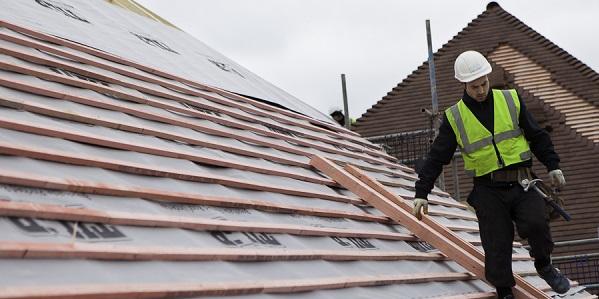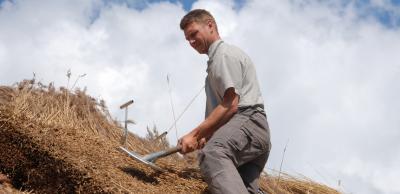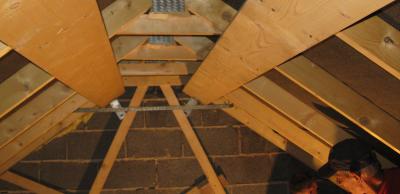Fixing of roof tiles
Data released by LABC Warranty has revealed that one of the most common defects in 2022 related to the poor installation of traditional slate and tile roof coverings. So, if you believe having a good understanding of the relevant code of practises is important, read on…
Part C2 of the Building Regulations, in both England and Wales, requires roofs to be constructed to adequately protect the building and people from precipitation including wind-driven spray, along with interstitial and surface condensation. This means that roofs should:
a) resist the penetration of precipitation to the inside of the building; and
b) not be damaged by precipitation and not carry precipitation to any part of the building which would be damaged by it; and
c) be designed and constructed so that their structural and thermal performance are not adversely affected by interstitial condensation.
One of the accepted approaches in helping to achieve the above is to follow the guidance in BS 8000-6.
What is BS 8000-6?
BS 8000-6 is the code of practise for slating and tiling of roofs and walls. The 1990 version of BS 8000-6 is cited in Approved Document C; however, a new draft 2023 version has recently been consulted on by BSI.
The current version of BS 8000-6 gives recommendations on basic workmanship on building sites, both commercial and domestic, and covers those tasks which are frequently carried out in relation to the slating and tiling of roofs and walls of newly constructed buildings or buildings being refurbished and re-roofed. It provides guidance on areas such as:
- Handling and preparation of materials;
- Preparation, laying and fixing of underlays, battens and verge underclocks;
- Laying and fixing of clay and concrete roof tiles, fittings and accessories;
- Laying and fixing of fibre cement slates, fittings and accessories;
- Laying and fixing of natural slates, fittings and accessories.
The guidance given in BS 8000-6 is not necessarily comprehensive, therefore in multiple places readers are referred to BS 5534 for additional technical information.
What is BS 5534?
BS 5534 is the code of practice for slating and tiling for pitched roofs and vertical cladding. It gives detailed recommendations for the design, performance and installation of new build pitched roofs, including vertical cladding, and for normal re-roofing work, including repairs, using slates, tiles, shingles and shakes and their associated components. Designers, manufacturers and installers of roofing products may find the guidance in BS 5534 of use.
The current version of BS 5534 was released in 2014.
The changes in 2014 were driven by changing weather conditions, which were putting strain on roofs and increasing insurance claims. There was also a need to align with European Standards and equivalent Eurocodes.
The 2014 amendments provided guidance that mortar could no longer be relied upon as the only means of securing tiles. Single-lap roof tiles and hip and ridge tiles all had to be mechanically fixed regardless of the use of mortar, while tiles to the perimeter of a roof had to be fixed twice. Higher wind loads were assumed, requiring more fixings generally and improved guidelines on the installation of underlays.
This led to increased use of dry-fix products. However, it was reported that some dry-fixed systems did not provide sufficient mechanical restraint. There were also reports that the design of some dry-fix verges meant that they were directing rainwater down the face of the wall, rather than away from it, causing black staining to many gable ends (particularly evident on rendered finishes).
Furthermore, there had been a number of reports that lightweight underlays had not been installed correctly, in particular, the degree of drape when laid unsupported over rafters.
In light of these issues, BS 5534 was amended in 2018. The key changes were:
- BS 5534 now refers to BS 8612:2018: Dry-fixed ridge, hip, and verge systems for slating and tiling – Specification. This British Standard provides guidance and practical advice on fixing security, weather-tightness, durability and where required, ventilation. Its aim is to ensure that dry-fix ridge and hip systems are designed and built in such a way that they fulfil the essential requirements of new and refurbished roofs. BS 8612 defines tests to determine mechanical resistance to wind load and shows how specifiers should use data from these tests to verify whether a product is suitable or not, given the wind exposure of the location of the application site. It also provides guidance on roof verges shedding rainwater away from the surface of the gable wall, to avoid staining and damp issues. Furthermore, the type and quality of some material are also specified, with respect to durability – plastics must withstand UV exposure without changing colour or properties, and ridge-roll products must cope with freeze-thaw cycles and the impacts of heat and humidity.
- Several changes were introduced to make sure that underlays are installed correctly, including:
- Ensuring underlays are installed with a maximum drape of 15mm. This prevents the transfer of wind loads to the roof covering for which it has not been designed to resist.
- Avoid leaving underlays exposed for any length of time. Over-exposure to UV light could lead to premature failure of underlays. Therefore, in certain conditions, particularly if there is persistent heavy rainfall combined with subsequent severe freeze-thaw cycles, an underlay should not be exposed for more than a few days. If an underlay has to be left without a roof covering for a period of time, when adverse weather is expected, a tarpaulin or similar protective sheeting may be used to protect the underlay until such time that the roof covering can be completed.
- Ensuring when counter battens are used above an underlay the eaves detail is designed to avoid troughs and to allow any surface moisture to drain effectively into the gutter.
- Wind uplift resistance of self-supporting underlays was included. A pressure test has been introduced to determine the wind uplift resistance of underlays in order to determine their scope of application and classification.
Further guidance on the requirements relating to the installation of traditional slate and tile roof coverings can also be found in the LABC Warranty Technical Manual available here.
Please Note: Every care was taken to ensure the information was correct at the time of publication. Any written guidance provided does not replace the user’s professional judgement. It is the responsibility of the dutyholder or person carrying out the work to ensure compliance with relevant building regulations or applicable technical standards.
Sign up to the building bulletin newsletter
Over 48,000 construction professionals have already signed up for the LABC Building Bulletin.
Join them and receive useful tips, practical technical information and industry news by email once every 6 weeks.
Subscribe to the Building Bulletin




Comments
Fixing of roof tiles
Submitted 1 year 4 months ago
Furthermore, there had been a number of reports that lightweight underlays had not been installed correctly, in particular, the degree of drape when laid unsupported over rafters.
Ychwanegu sylw newydd